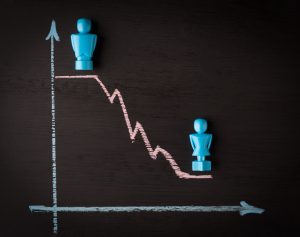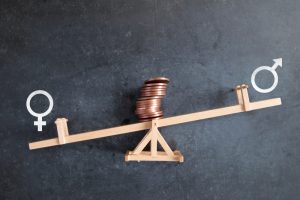I read a story recently about a well-known UK comedian, author and Radio 4 presenter called Sandi Toksvig, who studied Anthropology at university. One day a professor held up a photograph of an antler bone with 28 markings on it.
“This,” said the professor, “is alleged to be man’s first attempt at a calendar,” Toksvig admitted that she and her fellow students looked at the bone in admiration.
“Tell me,” the professor continued, “what man needs to know when 28 days have passed? I suspect that this is actually a woman’s first attempt at a calendar!”
While smiling at the reference to how women are aware of 28-day cycles, (and I suspect many husbands and partners are too!) it made me reflect on how unconsciously from the early days of human existence, we have referred to the “evolution of man and mankind” rather than “people”.
These are common examples of how gender gets labelled in the way we speak and communicate. It’s likely always going to be there at some level. However let’s be honest, there is one area on the gender debate which needs to be challenged and that is the gender pay gap.
The facts are that the gender pay gap continues to be an example of social injustice.
While it may make uncomfortable reading at times, unless we know what we are dealing with, organisations and leaders can’t plan to make the changes that are required to build equality.
Today I want to share some of the most recent data on gender inequality and examples of where progress has been made that will inspire leaders, and their organisations to pick up the baton and drive the pace of change.
Gender Pay Gap
 Currently, the most accurate and complete data source on pay growth, gaps and how this relates across both the male and female population is the United Nations International Labour Organisation.
Currently, the most accurate and complete data source on pay growth, gaps and how this relates across both the male and female population is the United Nations International Labour Organisation.
Here are a few facts:
- The global wage growth in 2017 was not only lower than in 2016 but fell to its lowest growth rate since 2008, remaining below the levels obtained before the global financial crisis.
- In the advanced G20 countries, real wage growth declined from 1.7 per cent in 2015 to 0.9 per cent in 2016 and 0.4 per cent in 2017.
- Based on data for 73 countries that cover about 80 per cent of the world’s employees
– the (weighted) global gender pay gap stands at around 16 per cent. - In many countries, women are more highly educated than men within the same occupational categories but earn lower wages. The Global Wage Report 2018/19 suggests that this illustrates the fact that women tend to have lower income returns for their education than men, even when they work in the same occupational category.
What about the UK? Surely, it’s different here? Let’s explore a few UK based data points.
- In 74% of companies, men have a higher rate of pay.
- Just 15% of businesses with more than 250 employees pay more to women.
- The average gender pay gap across all UK medium and large-sized firms is now 8.2%, as measured by median pay.
It makes for sobering reading, yet there are some great examples of organisations who are leading the way in change.
As an example, at Unilever UK, women earn around 9 per cent more than men, reflective of the fact that 70 per cent of those working in manufacturing roles are male, while women occupy more than half (50.7 per cent) of all management positions at the consumer goods giant. [Ref 1]
Salesforce, the US cloud-based software company, invested $2.7m to adjust the salaries of 6% of its global 30,000-person workforce, to address inequality regarding gender, race and ethnicity.
[Ref 2]
Great examples from Unilever and Salesforce, so what other strategies could be used to reduce the pay gap?
Let’s review a few common ones currently being used.
Reducing Job Advertising Gender Bias
 As a start, reducing gender bias in job advertising to improve the balance between genders employed in organisations where men and women are performing the same role.
As a start, reducing gender bias in job advertising to improve the balance between genders employed in organisations where men and women are performing the same role.
In 2017 the online job board Totaljobs found that out of 75,000 job ads posted on their website, 478,175 words were thought to carry a gender bias; oh dear!
With job adverts varying from two to six hundred words, this is significant.
Adverts for jobs such as social care and admin roles were most likely to use female-biased language, at 87% and 67% respectively. Examples being words like supportive, cooperative, loyal, or understanding.
In contrast sales and management roles were among the ads most likely to use male-biased language, such as lead, analyse, active and confident.
There isn’t an excuse for this today as software is available that will scan adverts to reduce bias. Companies including Microsoft, Slack, Twitter and Dropbox all use an online bias detector to scan their job ads.
Applying Targets to Reduce The Pay Gap
Setting targets and planning the budgets required to close the gap is essential. For example, Accenture, the global management consulting company is attempting to close the pay gap in several ways.
- Setting gender targets to increase the number of women across a range of different positions.
- Offering referral bonuses for women and minority hires.
- Offering sponsorship for the company’s senior women to advance their careers.
While you may think these strategies do not put additional money into someone’s bank account today, it is encouraging to see an organisation of this stature planning for the long term too.
Have Diversity in Your Management Team
 Senior leaders have the most significant influence over promotions and pay increases, and as we know, men currently tend to dominate the upper levels of most companies.
Senior leaders have the most significant influence over promotions and pay increases, and as we know, men currently tend to dominate the upper levels of most companies.
An audit will allow you to review the balance of men and women at the different management levels in your company. If there are fewer women the further up the ladder you go, it’s a sign there is a systemic problem that needs addressing through your recruiting process.
How is your organisation addressing the gender pay inequality issue? I’d be interested to hear
what approaches your company is using.
Thanks,
Rachel Hewitt-Hall
Ref 1 https://bit.ly/2EhyQ4q
Ref 2 https://yhoo.it/2GmgkXb
About Excel Communications
Excel Communications has a 30+ year history as a global leadership and communication skills company providing training and development to organisations across the globe, view our case studies here.
We have a team of expert trainers delivering programmes across four continents in multiple languages. Call us now on +44 (0) 1628 488 854.
Important
If you would like to watch our leadership masterclass recordings, you can access the latest complimentary guide here.
